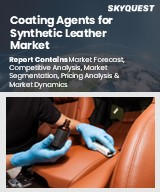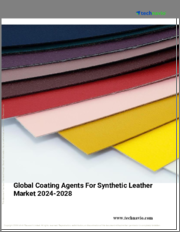
|
시장보고서
상품코드
1772726
합성피혁용 코팅제 시장 규모, 점유율, 성장 분석 : 수지 유형별, 배합별, 용도별, 지역별 - 산업 예측(2025-2032년)Coating Agents for Synthetic Leather Market Size, Share, and Growth Analysis, By Resin Type (PU, PVC), By Formulation (Acrylic, Polyurethane), By Application, By Region - Industry Forecast 2025-2032 |
||||||
세계의 합성피혁용 코팅제 시장 규모는 2023년에 2억 4,000만 달러로 평가되며, 2024년 2억 5,752만 달러에서 2032년까지 4억 5,249만 달러로 성장하며, 예측 기간(2025-2032년)의 CAGR은 7.3%로 성장할 전망입니다.
합성피혁에 사용되는 코팅제 세계 시장은 자동차, 패션, 실내 장식 등의 산업이 주도하여 큰 성장을 달성하고 있습니다. 제조업체들은 비용 효율성과 지속가능성을 유지하면서 가죽의 촉감과 미적 품질을 재현하고자 노력하고 있으며, 이러한 약제는 표면의 맞춤형성, 자외선 저항성, 색상 유지력을 향상시키는 데 필수적입니다. 이러한 코팅 합성 기판 증가는 새로운 성능 기준과 규제 요건을 충족하는 혁신적인 제품에 대한 수요를 촉진할 것입니다. 환경 친화적인 제조 방식과 지속가능한 재료로의 전환은 시장 상황을 변화시키고 있으며, 규제는 솔벤트 기반 시스템에서 수성 및 바이오 대체품으로의 전환을 촉진하고 있습니다. 그 결과, 우수한 접착력과 내마모성, 저휘발성 화합물을 제공하는 차세대 코팅 화학물질에 대한 요구가 증가하고 있습니다.
목차
서론
- 조사의 목적
- 조사 범위
- 정의
조사 방법
- 정보 조달
- 2차와 1차 데이터 방법
- 시장 규모 예측
- 시장의 전제조건과 제한
개요
- 세계 시장 전망
- 공급과 수요 동향 분석
- 부문별 기회 분석
시장 역학과 전망
- 시장 개요
- 시장 규모
- 시장 역학
- 촉진요인과 기회
- 억제요인과 과제
- Porter의 산업 분석
주요 시장 인사이트
- 주요 성공 요인
- 경쟁의 정도
- 주요 투자 기회
- 시장 에코시스템
- 시장의 매력 지수(2024년)
- PESTEL 분석
- 거시경제 지표
- 밸류체인 분석
- 가격 분석
- 기술 분석
- 사례 연구
세계의 합성피혁용 코팅제 시장 규모 : 수지 유형별·CAGR(2025-2032년)
- 시장 개요
- PU
- PVC
- 실리콘
- 기타 수지 유형
세계의 합성피혁용 코팅제 시장 규모 : 배합별·CAGR(2025-2032년)
- 시장 개요
- 아크릴
- 폴리우레탄
- 폴리에스테르
- 에폭시
세계의 합성피혁용 코팅제 시장 규모 : 용도별·CAGR(2025-2032년)
- 시장 개요
- 자동차
- 가구·가정용 업홀스터리
- 신발
- 섬유·패션
- 교통기관
- 기타 용도
세계의 합성피혁용 코팅제 시장 규모·CAGR(2025-2032년)
- 북미
- 미국
- 캐나다
- 유럽
- 독일
- 스페인
- 프랑스
- 영국
- 이탈리아
- 기타 유럽 지역
- 아시아태평양
- 중국
- 인도
- 일본
- 한국
- 기타 아시아태평양
- 라틴아메리카
- 브라질
- 기타 라틴아메리카 지역
- 중동 및 아프리카
- GCC 국가
- 남아프리카공화국
- 기타 중동 및 아프리카
경쟁 정보
- 상위 5사의 비교
- 주요 기업의 시장 포지셔닝(2024년)
- 주요 시장 기업이 채택한 전략
- 최근 시장 동향
- 기업의 시장 점유율 분석(2024년)
- 주요 기업의 기업 개요
- 기업의 상세
- 제품 포트폴리오 분석
- 기업의 부문별 점유율 분석
- 매출의 전년대비 비교(2022-2024년)
주요 기업 개요
- Stahl Holdings B.V.
- LANXESS
- Evonik Industries AG
- Covestro AG
- Elkem ASA
- Abhilash Chemicals and Pharmaceuticals Pvt Ltd
- CHT Group
- Dow
- Jasch Industries Limited
- Papertex Speciality Chemicals Pvt Ltd
- ROWA GROUP Holding GmbH
- W. R. Grace & Co.-Conn.
- Wacker Chemie AG
결론과 제안
KSA 25.07.25Global Coating Agents for Synthetic Leather Market size was valued at USD 240.0 million in 2023 and is poised to grow from USD 257.52 million in 2024 to USD 452.49 million by 2032, growing at a CAGR of 7.3% during the forecast period (2025-2032).
The global market for coating agents used in synthetic leather is experiencing significant growth, driven by industries such as automotive, fashion, and upholstery. As manufacturers seek to replicate the tactile and aesthetic qualities of genuine leather while maintaining cost-effectiveness and sustainability, these agents are essential for enhancing surface customization, UV resistance, and color retention. This rise in coated synthetic substrates propels demand for innovative products that meet new performance standards and regulatory requirements. The shift towards eco-friendly manufacturing practices and sustainable materials is transforming the market landscape, with regulations prompting a move away from solvent-based systems to water-based and bio-based alternatives. Consequently, there is a growing need for next-generation coating chemistries that offer low volatile compounds alongside superior adhesion and abrasion resistance.
Top-down and bottom-up approaches were used to estimate and validate the size of the Global Coating Agents for Synthetic Leather market and to estimate the size of various other dependent submarkets. The research methodology used to estimate the market size includes the following details: The key players in the market were identified through secondary research, and their market shares in the respective regions were determined through primary and secondary research. This entire procedure includes the study of the annual and financial reports of the top market players and extensive interviews for key insights from industry leaders such as CEOs, VPs, directors, and marketing executives. All percentage shares split, and breakdowns were determined using secondary sources and verified through Primary sources. All possible parameters that affect the markets covered in this research study have been accounted for, viewed in extensive detail, verified through primary research, and analyzed to get the final quantitative and qualitative data.
Global Coating Agents for Synthetic Leather Market Segments Analysis
Global Coating Agents for Synthetic Leather Market is segmented by Resin Type, Formulation, Application and region. Based on Resin Type, the market is segmented into PU, PVC, Silicone and Other Resin Types. Based on Formulation, the market is segmented into Acrylic, Polyurethane, Polyester and Epoxy. Based on Application, the market is segmented into Automotive, Furniture and Domestic Upholstery, Footwear, Textile and Fashion, Transportation and Other Applications. Based on region, the market is segmented into North America, Europe, Asia Pacific, Latin America and Middle East & Africa.
Driver of the Global Coating Agents for Synthetic Leather Market
The rising regulations concerning animal welfare and the heightened awareness regarding environmental issues are driving the demand for synthetic leather alternatives. As consumers increasingly seek eco-friendly and cruelty-free options, the need for effective coating agents becomes essential, enhancing the durability, appearance, and sustainability of synthetic leather products. This shift towards more sustainable materials is significantly impacting various industries, including automotive, fashion, and furniture, thereby fueling growth in the global market for coating agents used in synthetic leather. These developments reflect a broader trend towards responsible consumer behavior and a commitment to reducing reliance on traditional, animal-based leather.
Restraints in the Global Coating Agents for Synthetic Leather Market
The Global Coating Agents for Synthetic Leather market faces certain restraints due to the emergence of new coating agents that offer enhanced performance and environmental benefits. However, the elevated costs associated with their formulation and processing can be a barrier, particularly in price-sensitive markets. While small and medium-sized enterprises aim to provide these innovative solutions, the challenge of scaling production effectively hinders their ability to penetrate wider market segments. This limitation particularly affects growth potential in developing economies, where the adoption of advanced materials may be slower due to budget constraints and the need for cost-effective alternatives.
Market Trends of the Global Coating Agents for Synthetic Leather Market
The global coating agents for synthetic leather market is experiencing a significant shift towards sustainable and bio-based solutions, reflecting evolving consumer preferences and stringent environmental regulations. The adoption of waterborne coatings and renewable raw materials is becoming more prevalent, aiming to reduce VOC emissions and enhance eco-friendliness in production processes. This trend not only aligns with the growing demand for environmentally responsible products but also positions manufacturers favorably in a competitive landscape that increasingly values sustainability. As industry stakeholders prioritize greener alternatives, the future of the synthetic leather coating segment looks set to embrace innovation while addressing ecological concerns.
Table of Contents
Introduction
- Objectives of the Study
- Scope of the Report
- Definitions
Research Methodology
- Information Procurement
- Secondary & Primary Data Methods
- Market Size Estimation
- Market Assumptions & Limitations
Executive Summary
- Global Market Outlook
- Supply & Demand Trend Analysis
- Segmental Opportunity Analysis
Market Dynamics & Outlook
- Market Overview
- Market Size
- Market Dynamics
- Drivers & Opportunities
- Restraints & Challenges
- Porters Analysis
- Competitive rivalry
- Threat of substitute
- Bargaining power of buyers
- Threat of new entrants
- Bargaining power of suppliers
Key Market Insights
- Key Success Factors
- Degree of Competition
- Top Investment Pockets
- Market Ecosystem
- Market Attractiveness Index, 2024
- PESTEL Analysis
- Macro-Economic Indicators
- Value Chain Analysis
- Pricing Analysis
- Technology Analysis
- Case Studies
Global Coating Agents for Synthetic Leather Market Size by Resin Type & CAGR (2025-2032)
- Market Overview
- PU
- PVC
- Silicone
- Other Resin Types
Global Coating Agents for Synthetic Leather Market Size by Formulation & CAGR (2025-2032)
- Market Overview
- Acrylic
- Polyurethane
- Polyester
- Epoxy
Global Coating Agents for Synthetic Leather Market Size by Application & CAGR (2025-2032)
- Market Overview
- Automotive
- Furniture and Domestic Upholstery
- Footwear
- Textile and Fashion
- Transportation
- Other Applications
Global Coating Agents for Synthetic Leather Market Size & CAGR (2025-2032)
- North America (Resin Type, Formulation, Application)
- US
- Canada
- Europe (Resin Type, Formulation, Application)
- Germany
- Spain
- France
- UK
- Italy
- Rest of Europe
- Asia Pacific (Resin Type, Formulation, Application)
- China
- India
- Japan
- South Korea
- Rest of Asia-Pacific
- Latin America (Resin Type, Formulation, Application)
- Brazil
- Rest of Latin America
- Middle East & Africa (Resin Type, Formulation, Application)
- GCC Countries
- South Africa
- Rest of Middle East & Africa
Competitive Intelligence
- Top 5 Player Comparison
- Market Positioning of Key Players, 2024
- Strategies Adopted by Key Market Players
- Recent Developments in the Market
- Company Market Share Analysis, 2024
- Company Profiles of All Key Players
- Company Details
- Product Portfolio Analysis
- Company's Segmental Share Analysis
- Revenue Y-O-Y Comparison (2022-2024)
Key Company Profiles
- Stahl Holdings B.V.
- Company Overview
- Business Segment Overview
- Financial Updates
- Key Developments
- LANXESS
- Company Overview
- Business Segment Overview
- Financial Updates
- Key Developments
- Evonik Industries AG
- Company Overview
- Business Segment Overview
- Financial Updates
- Key Developments
- Covestro AG
- Company Overview
- Business Segment Overview
- Financial Updates
- Key Developments
- Elkem ASA
- Company Overview
- Business Segment Overview
- Financial Updates
- Key Developments
- Abhilash Chemicals and Pharmaceuticals Pvt Ltd
- Company Overview
- Business Segment Overview
- Financial Updates
- Key Developments
- CHT Group
- Company Overview
- Business Segment Overview
- Financial Updates
- Key Developments
- Dow
- Company Overview
- Business Segment Overview
- Financial Updates
- Key Developments
- Jasch Industries Limited
- Company Overview
- Business Segment Overview
- Financial Updates
- Key Developments
- Papertex Speciality Chemicals Pvt Ltd
- Company Overview
- Business Segment Overview
- Financial Updates
- Key Developments
- ROWA GROUP Holding GmbH
- Company Overview
- Business Segment Overview
- Financial Updates
- Key Developments
- W. R. Grace & Co.-Conn.
- Company Overview
- Business Segment Overview
- Financial Updates
- Key Developments
- Wacker Chemie AG
- Company Overview
- Business Segment Overview
- Financial Updates
- Key Developments
















